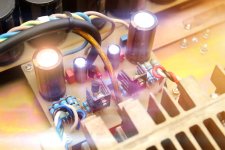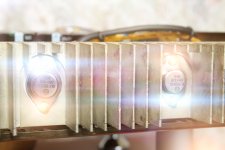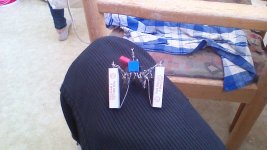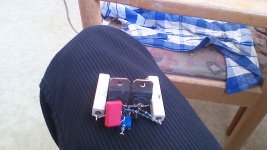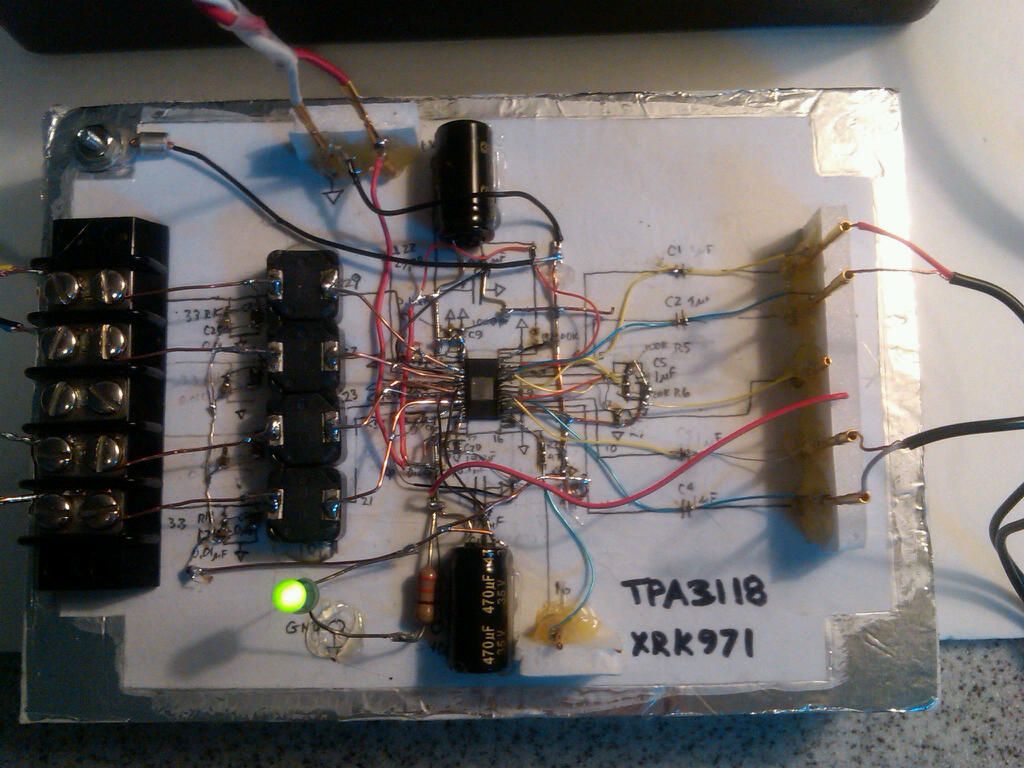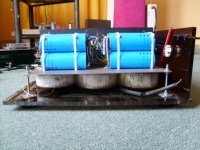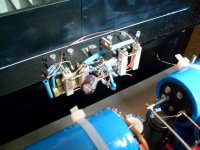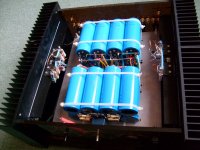My focus is on complementary-parts-steps. These sound much different, have much different characters (and cascodes, darlingtons and others get the influence in noise, in, at moment not regarded, distortions - every alteration of the signal - of all - involved active too - parts). The sum of (very much different) parts decide on how clean. The Hiraga, i did tuned some, I did build some, is a rumbling thing. Much fun, but never a clean tone.
What is your definition of clean tone? Do you know any of commercial amps or diy amps had that characteristic?
Onsemi still make these............... high quality transistors like the obsolete MJL1302/3281..............
MJL1302A: Bipolar Power Transistor, PNP, 15 A, 260 V, 200 Watt
I bought the MJL some 4 years ago when Farnell wrote in their newsletter that they were top of the bill. Strange. How fast goes obsolescence...
I've a very old JVC amp with nice big flat outputs (the type with 2 holes) and test these.
I've a very old JVC amp with nice big flat outputs (the type with 2 holes) and test these.
The most se sound clean. Stuff as first watt 1 - 3. Or most se-tubes. Result of less parts, less stages, no different stages (pp) or very different stages (complementary-pp). The most tubeamps have got better psus (c-l-c as example). But: clean speakers are necessary to assess - no multiway, no crossovers, no rumblimg wooden-casings, tuned drivers ...
And clean sources: no wadia, no teac ... no massive recordplayers ... no complex multistage-riaa ...
My mind,-!
And clean sources: no wadia, no teac ... no massive recordplayers ... no complex multistage-riaa ...
My mind,-!
Anyone have an opinion about using MJL 1302 and 3281 as outputs? According to Farnell these are high quality audio transistors.
One of the best. Now I using MJ15024G+MJ15025G, cause my heatsinks made for TO-3.
Attachments
I see you are using a twisted triplet to feed the Output BJTs.
I have been asking a few Members (after they claimed to know) and no one would actually commit to wiring layout advice.
I have been asking a few Members (after they claimed to know) and no one would actually commit to wiring layout advice.
I see you are using a twisted triplet to feed the Output BJTs.
I have been asking a few Members (after they claimed to know) and no one would actually commit to wiring layout advice.
Not understood... Why twisted or what?..
Damon,
your left pic shows a twisted triplet feeding each of the output BJTs.
Can you see that?
Black/blue/white to the left BJT and black/red/white to the right BJT.
your left pic shows a twisted triplet feeding each of the output BJTs.
Can you see that?
Black/blue/white to the left BJT and black/red/white to the right BJT.
The most se sound clean. Stuff as first watt 1 - 3. Or most se-tubes. Result of less parts, less stages, no different stages (pp) or very different stages (complementary-pp). The most tubeamps have got better psus (c-l-c as example). But: clean speakers are necessary to assess - no multiway, no crossovers, no rumblimg wooden-casings, tuned drivers ...
And clean sources: no wadia, no teac ... no massive recordplayers ... no complex multistage-riaa ...
My mind,-!
You have a point there. But it may be personal taste. I also like my SS SE amp than Hiraga amp, my amp based on Power Follower with addition stage and gain, its topic was somewhere in this forum.
Lie around for ten years or more ...
two pairs of "Le Monstre", two pairs of "Le Classe A" and others. A little angle to attach, and they would run. But it hurts my ears, my aesthetic,-)
Do you not listen the difference, clean or less clean,-?
Some suggestions for the origin Classe A:
Replace the big copper strands by solid core, 1,5 mm.
New order of ground an C-R-C - look picture.
Replace the origin bridging cap by x times 220 uF or others, same types! same values! as much as possible.
Input only one channel ground - I prefer right.
Psu - amp: 0,6 mm.
Input - amp: max 0,2 mm.
Amp - output: 0,6 mm.
NO lace! Exept laqueured lace.
... to get a much cleaner, finer sounding origin - or diy - "Le Classe A"-!!!
two pairs of "Le Monstre", two pairs of "Le Classe A" and others. A little angle to attach, and they would run. But it hurts my ears, my aesthetic,-)
Do you not listen the difference, clean or less clean,-?
Some suggestions for the origin Classe A:
Replace the big copper strands by solid core, 1,5 mm.
New order of ground an C-R-C - look picture.
Replace the origin bridging cap by x times 220 uF or others, same types! same values! as much as possible.
Input only one channel ground - I prefer right.
Psu - amp: 0,6 mm.
Input - amp: max 0,2 mm.
Amp - output: 0,6 mm.
NO lace! Exept laqueured lace.
... to get a much cleaner, finer sounding origin - or diy - "Le Classe A"-!!!
Attachments
Lie around for ten years or more ...
two pairs of "Le Monstre", two pairs of "Le Classe A" and others. A little angle to attach, and they would run. But it hurts my ears, my aesthetic,-)
Do you not listen the difference, clean or less clean,-?
Some suggestions for the origin Classe A:
Replace the big copper strands by solid core, 1,5 mm.
New order of ground an C-R-C - look picture.
Replace the origin bridging cap by x times 220 uF or others, same types! same values! as much as possible.
Input only one channel ground - I prefer right.
Psu - amp: 0,6 mm.
Input - amp: max 0,2 mm.
Amp - output: 0,6 mm.
NO lace! Exept laqueured lace.
... to get a much cleaner, finer sounding origin - or diy - "Le Classe A"-!!!
Are these 3D dead bug amps truly PCB free? Do you have one attached to a heat sink and peripherals like inputs, power, output? It would be cool to see how you manage all that without having something bolted down. Cool looking though.
Truly pcb-free.-) The psus too,-)
But complementary-parts-designs are history.-) Long long ago.
May be, I have some photographs anywhere. I do not know.
But complementary-parts-designs are history.-) Long long ago.
May be, I have some photographs anywhere. I do not know.
Damon,
your left pic shows a twisted triplet feeding each of the output BJTs.
Can you see that?
Black/blue/white to the left BJT and black/red/white to the right BJT.
Aaa.🙂 Black=Base, white=emitter, red= + collector, blue= - collector.🙂
Guys, someone was saying something about using multiple resistors to get 0.33 or 0.4 ohm..... Can't find that post anymore. But it was supposed to improve the Hiraga a lot. Does anyone get this? And what types should be used? Wirewound?
Thanks!
Thanks!
Guys, someone was saying something about using multiple resistors to get 0.33 or 0.4 ohm..... Can't find that post anymore. But it was supposed to improve the Hiraga a lot. Does anyone get this? And what types should be used? Wirewound?
Thanks!
You don't nesscilary have to have emitter reistors, you can operate without them
Guys, someone was saying something about using multiple resistors to get 0.33 or 0.4 ohm..... Can't find that post anymore. But it was supposed to improve the Hiraga a lot. Does anyone get this? And what types should be used? Wirewound?
Thanks!
Hi Sjoerd,
Yup, it does improve the sound clarity and other aspects allot and lower the overall noise. To get 0.33 you need to parallel 3 pcs of 1ohm @3w ,metal oxyde. These will get hot even at 3w but acceptable. Or wirewound non inductive types could be used here . I havent tested wirewound n.i. but have tested simple wirewounds and will never go back to them.
Cheers
Sergiu
- Home
- Amplifiers
- Solid State
- Hiraga 20W class A
